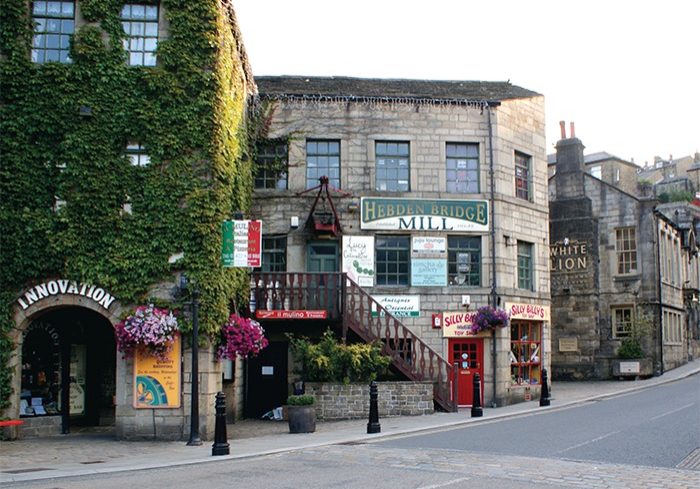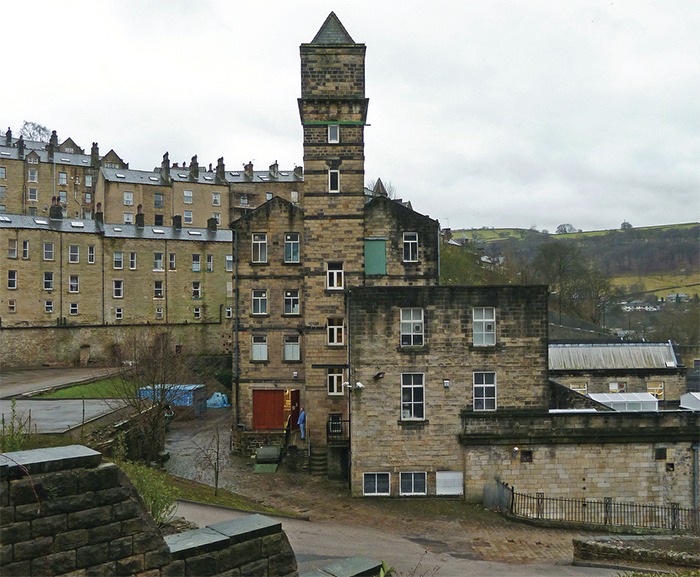
Hebden Bridge
by Northern Life
A Town on the Up
Hebden Bridge is the town that bounced back again and again. Last year, Northern Life reported how shops and other businesses recovered from the effects of devastating floods that struck not just once but twice. In this article, local historian and eco-campaigner David Fletcher, owner and restorer of the historical Bridge Mill, tells of an earlier revival when the town refused to die, after its once-booming textile industry was all but wiped out.
Industry in Hebden Bridge peaked in the early 1890s, with a slow decline until the 1950/60s when it was almost wiped out over a ten-year period. Thirty-three factories closed forever. People left to seek work elsewhere. Dereliction, depopulation and despair left a ghost town in its wake, abandoned by governments of all colours.
But those who prematurely wrote off this area overlooked one very important asset which remained; the tenacity, determination and energy of those local people who remained and strove to reinvent the town and prepare it for a new future.
The 12th May 1965 saw the start of a new crusade by local residents to fight back against the neglect, dereliction and disorder brought about by the widespread demoralisation.
A public meeting called in the former Civic Hall on Crown Street (now the ‘Bar-Place hotel) attracted over 100 people who agreed a programme of voluntary work to enhance the image of the town and generate increased local pride of place. Week-end working parties were well attended and over the next couple of years thousands of new trees were planted in and around the town; buildings cleaned to expose the golden stonework beneath the years accumulation of industrial grime; yearsworth of rubbish removed from the river and campaigns mounted for clean air and water.
A four-part strategy developed. Its aims: to clean up the local environment and present a more positive image; promote events to attract visitors and tourists; convert visitors to full-time residents; and, lastly, to safeguard derelict industrial buildings for conversion to future employment opportunities.
The strategy soon paid off well. The clean-up proved popular and was well supported. Events brought much press and TV coverage.
Visitor numbers began to build and they increasingly sought to take advantage of low property prices in an area becoming increasingly attractive. The first to come became known as the Hebden Bridge hippies; Reg and Marion and the Foster Clough hippies; interesting and creative people. They brought much added value to the area, which is more than can be said for some of their later imitators such as the Queen’s Terrace squatters, who abused both the buildings and the areas around them.
But the general trend was upwards and where the hippies pioneered, larger numbers of young professionals from Manchester and Leeds began to follow, bringing their own cultural contributions, helping to build the image of Hebden Bridge as a somewhat offbeat artistic and creative centre.
Its annual Arts Festival, Gallery Trail, music venues and opportunities for active participation in all manner of activities are now widely known and appreciated.
In recent years, the town has won many awards and accolades, including the British Airways Inflight magazine’s ‘Funkiest Town in Europe’; The New Economics Foundation’s ‘Least Cloned Town in Britain’; and the Academy of Urbanism, 2011 award for the ‘Best Small Town in Britain and Ireland.’
The relatively recent partnership project between Calderdale Council and the Town Partnership to pedestrianise and landscape a large part of the central area has given a boost to the regeneration initiative. Safeguarding large former industrial buildings and attracting new employment activities has proved to be more challenging but is also making startling progress. One of the first steps was the formation in 1979 of Pennine Heritage Ltd by a group of local conservationists, including some from the former Calder Civic Trust, as an active development company and registered charity.
Taking on the challenge of the largest redundant abandoned mill in town, the five-storey Nutclough Mill, a monument to the early producer-cooperative movement, over £1million was raised to rescue and adapt this building to industrial reuse. Now occupied by Calrec Audio Ltd, not only has an important historic building been saved, but also around 150 high-tech jobs created for local people. This exemplifies the purpose of the Pennine Heritage Trust and those volunteers who continue to manage its activities.(For further information about its current project see Pennine Horizons, <a href=”http://www.penninehorizons. org.uk”>www.penninehorizons. org.uk</a>).
Possibly, the initial pioneering project focusing attention on the need to save such structures and the benefits to be obtained is the restoration of Hebden Bridge Mill itself. This building, by far the oldest in the town, situated at its core, having given its name to the whole settlement, was in 1972 threatened with demolition.
To save it from this sad fate, the mill was purchased by its current owner, the former chairman of Calder Civic Trust and instigator of Pennine Heritage. The long process of recovery began. Unable to raise external finance, progress was slow and depended mainly on 20-hour DIY weekends.
In the absence of any grant aid or external funding, public patronage over the years has helped restore this ancient mill, now listed as a building of historic importance. Gradually, area by area, the whole building has been brought back into use to support a growing family of activities. The waterwheel was restored as a project for the Millennium and work has now been completed to once more rely on water and solar power rather than the national grid.
Together with the waterwheel, an Archimedes screw turbine generates electricity, a water source heat pump warms the building, and solar panels provide hot water. The green-sourced electricity even powers the owner’s Renault Twizy, a little electric two-seater that runs a handy 50 miles between its twice-weekly charges.




